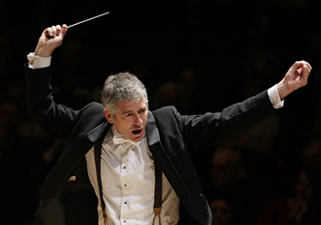When two music scholars collaborate on a Beethoven project, one can anticipate the unexpected. Katharina Uhde (violin) and R. Larry Todd (piano) presented Part I of their results: the Op. 12 sonatas for piano and violin. Their singular performance was preceded by Professor Todd’s insightful lecture to which he humorously referred to as “Salieri’s Revenge.” The lecture and performance took place in the Nelson Music Room on the campus of Duke University.
Why the dedication to Antonio Salieri? Professor Todd led us through his argument beginning with an unpublished set of variations Beethoven created from a simple theme from Salieri’s Falstaff. Beethoven’s embellishments proved his proficiency in the art of theme and variation and perhaps served as a portal into opera. Listening for this dramatic tendency Todd points out characteristics found in the violin sonatas. The first and third for example, “begin rather like operatic overtures . . .” With this in mind, the artists primed us with excerpts and gestures, like exaggerated sigh figures, that might signify operatic characters.
Uhde and Todd performed the so-called early, three-movement sonatas in order. Informed by an operatic impulse, they played with a vivid sensibility that illuminates how this music stands apart from the works of the same genre by Haydn and Mozart. To begin with, for example, one hears right away the equal partnership between the pianist and violinist. Material is shared, passed back and forth, embellished and if you listen carefully, turned into dialogue. In the second movement of the A major sonata, I picture two young lovers saying good-bye. In this movement, abrupt changes in dynamics and unexpected accents are prescient to the works that will follow in the coming years. And finally, the third sonata, in the heroic key of E-flat, leads directly into the middle period of Beethoven’s life as a composer.
Listening for evidence, I found myself immersed with rapt attention. Even Ms. Uhde’s small feathered hair clip projected a touch of theater. But there was no lack of sincerity in her playing. Knowing the music so well, she had the freedom to frequently communicate with the pianist. She even slipped in her own improvised cadenza in the third movement of the D major sonata. Breathing with her instrument, her phrasing was graceful, and articulation had the clarity and lightness of coloratura. Like Beethoven’s piano sonatas of the same period, Op. 12 holds treacherous passages that call for skilled hands. Todd played with great assuredness, including the bravura passages in the third sonata in E-flat. Together, they brought new life into music that has been performed and listened to for two-hundred years.
I have re- imagined Beethoven’s glorious music, this time with new ears. And discovering for myself dramatic gestures like sweeping three-octave scales, I have again fallen in love with Beethoven’s violin sonatas. My thanks to the artists for the dedication it took to bring us this elegant performance. I can’t wait to hear the crown jewel in the spring, “The Kreutzer.”
Katharina Uhde holds a DMA from the University of Michigan and is currently a doctoral student in musicology under the direction of Professor R. Larry Todd. Todd is Arts & Sciences Professor of Music and former chair of the Music Department at Duke.
Part II of this series was cancelled at the last minute on December 2; we will update our calendar with a new date a.s.a.p. As of this writing, Parts III and IV are scheduled for March 4 and 5, 2013.











